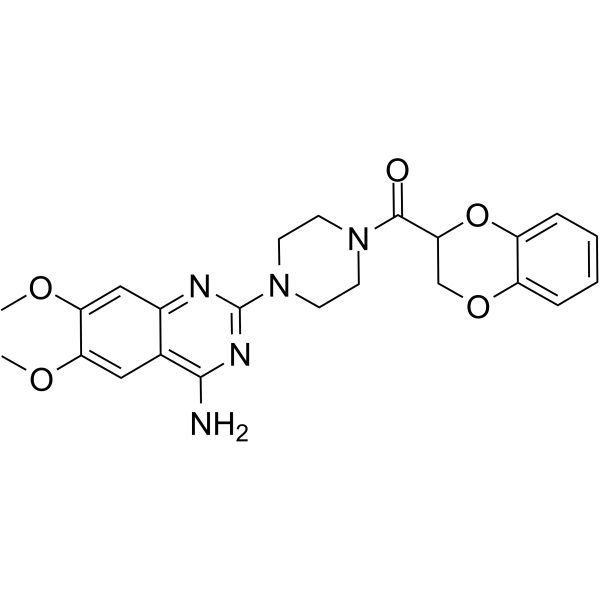
Doxazosin
CAS No. 74191-85-8
Doxazosin( UK 33274 )
Catalog No. M27548 CAS No. 74191-85-8
Doxazosin is a long-lasting inhibitor of α1-adrenoceptors that is widely used to treat benign prostatic hyperplasia and lower urinary tract symptoms.
Purity : >98% (HPLC)
 COA
COA
 Datasheet
Datasheet
 HNMR
HNMR
 HPLC
HPLC
 MSDS
MSDS
 Handing Instructions
Handing Instructions
| Size | Price / USD | Stock | Quantity |
| 5MG | 36 | In Stock |


|
| 10MG | 51 | In Stock |


|
| 25MG | 85 | In Stock |


|
| 50MG | 124 | In Stock |


|
| 100MG | 188 | In Stock |


|
| 200MG | 293 | In Stock |


|
| 500MG | Get Quote | In Stock |


|
| 1G | Get Quote | In Stock |


|
Biological Information
-
Product NameDoxazosin
-
NoteResearch use only, not for human use.
-
Brief DescriptionDoxazosin is a long-lasting inhibitor of α1-adrenoceptors that is widely used to treat benign prostatic hyperplasia and lower urinary tract symptoms.
-
DescriptionDoxazosin is a long-lasting inhibitor of α1-adrenoceptors that is widely used to treat benign prostatic hyperplasia and lower urinary tract symptoms.(In Vitro):Doxazosin, at concentrations of 5-20 mumol/L, increased LDL binding to hepatic cells in a dose-related manner. Also, in these hepatic cells, doxazosin produced dose-related decreases in both newly synthesized cholesterol and cholesterol ester. In rabbit fibroblasts that were LDL receptor negative, de novo cholesterol synthesis was markedly reduced by increasing concentrations of doxazosin. Taken together, these results suggest that doxazosin may have a direct inhibitory effect on cholesterol synthesis independent of the LDL receptor.(In Vivo):Both the enantiomers were highly bound to the plasma proteins of rats, dogs and humans [(-)doxazosin: 89.4%-94.3%; (+)doxazosin: 90.9%-95.4%]. (+)Doxazosin exhibited significantly higher protein binding capacities than (-)doxazosin in all the three species, and the difference in the bound concentration (Cb) between the two enantiomers was enhanced as their concentrations were increased. Although the percentage of the plasma protein binding in the dog plasma was significantly lower than that in the human plasma at 400 and 800 ng/mL, the corrected percentage of plasma protein binding was dog>human>rat.
-
In VitroDoxazosin(UK 33274) is a long-lasting inhibitor of α1-adrenoceptors that is widely used to treat benign prostatic hyperplasia and lower urinary tract symptoms. doxazosin may have a direct inhibitory effect on cholesterol synthesis independent of the LDL receptor. The inhibition of cholesterol synthesis by doxazosin may cause cells to compensate by upregulating the LDL receptor, thereby increasing the importation of lipoprotein cholesterol and reducing LDL cholesterol in the medium. Doxazosin monotherapy was effective in eight of 12 patients (66.7%), and combined therapy with a beta-blocker was effective in 11 of 12 patients (91.7%). The mean pulse rate remained constant throughout therapy. Adverse reactions were minor and transient and occurred in only three patients. Urinary and plasma catecholamine levels tended to decrease or remained unchanged during doxazosin therapy.
-
In Vivo——
-
SynonymsUK 33274
-
PathwayAngiogenesis
-
TargetAdrenergic Receptor
-
Recptor——
-
Research Area——
-
Indication——
Chemical Information
-
CAS Number74191-85-8
-
Formula Weight451.483
-
Molecular FormulaC23H25N5O5
-
Purity>98% (HPLC)
-
Solubility——
-
SMILESCOc1cc2nc(nc(N)c2cc1OC)N1CCN(CC1)C(=O)C1COc2ccccc2O1
-
Chemical Name——
Shipping & Storage Information
-
Storage(-20℃)
-
ShippingWith Ice Pack
-
Stability≥ 2 years
Reference
1.Grogan G, et al. An Aminocaprolactam Racemase from Ochrobactrum anthropi with Promiscuous Amino Acid Ester Racemase Activity. Chembiochem. 2018 Jun 13.
molnova catalog



related products
-
Clenbuterol hydrochl...
Clenbuterol hydrochloride is a β2 adrenergic receptor agonist. It is a powerful bronchodilator withfat burning properties.
-
Astragalus polypheno...
Astragalus polyphenols is a compound isolated from the roots of Polygonum species, inhibits the formation of 5-HETE, HHT and thromboxane B2.
-
SR59230A
MDMA (20 mg/kg) produces a slowly developing hyperthermia, reaching a maximum increase of 1.8°C at 130 min post injection.



 Cart
Cart
 sales@molnova.com
sales@molnova.com


